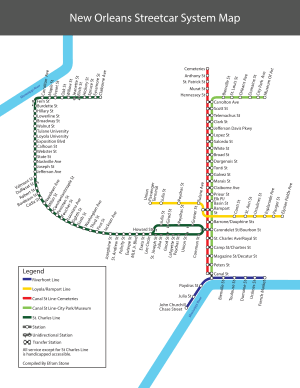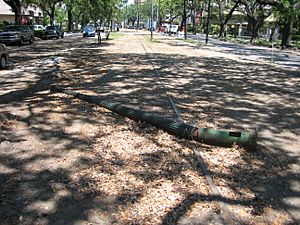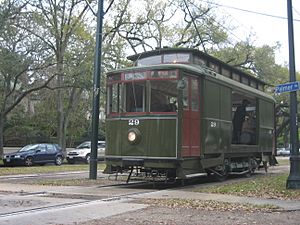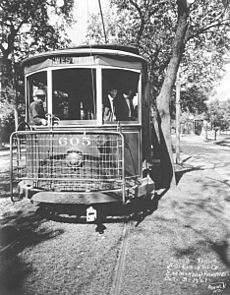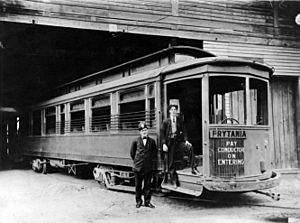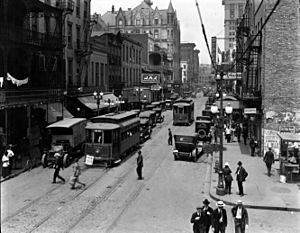Streetcars in New Orleans facts for kids

Streetcars on the Canal Street line.
|
|||
| Operation | |||
|---|---|---|---|
| Locale | New Orleans, Louisiana | ||
| Open | September 1835 (steam locomotives and horsecars) February 1893 (electric streetcars/trams) |
||
| Lines | 5 operating | ||
| Operator(s) | Transdev for New Orleans Regional Transit Authority (RTA) | ||
| Infrastructure | |||
| Track gauge | 5 ft 2 1⁄2 in (1,588 mm) Pennsylvania trolley gauge | ||
| Minimum curve radius | 28 ft (8.534 m) in yard, 50 ft (15.24 m) elsewhere |
||
| Electrification | 600 V DC trolley wire | ||
| Statistics | |||
| Route length | 22.3 mi (35.9 km) | ||
| Passengers (Daily) | 21,600 | ||
|
|||
Streetcars in New Orleans have been a key part of the city's public transportation for a very long time, starting in the early 1800s. The St. Charles Avenue line is the longest and the oldest streetcar system in the world that has been running without stopping. Today, the streetcars are managed by the New Orleans Regional Transit Authority (RTA).
New Orleans currently has five streetcar lines: the St. Charles Avenue Line, the Riverfront Line, the Canal Street Line (which has two parts), and the Loyola Avenue Line and Rampart/St. Claude Line (which run together as one). The St. Charles Avenue Line is the only one that has operated continuously throughout the city's history. However, its service was paused after Hurricane Katrina in August 2005 and slowly brought back by December 2006. Other lines were replaced by buses between the late 1940s and early 1960s. People who wanted to save the streetcars couldn't save the Canal Street ones, but they did convince the city to protect the St. Charles Avenue Line by making it a historic landmark. Later in the 20th century, people started to like rail transit again. A short Riverfront Line opened in 1988, and streetcar service returned to Canal Street in 2004, 40 years after it had stopped.
Hurricane Katrina caused a lot of damage to the city in August 2005, including the streetcar lines and many streetcars. Service on part of the Canal Street line was fixed by December of that year. The rest of the Canal line and the Riverfront line were back in service in early 2006. On December 23, 2007, the RTA brought back service on the St. Charles line from Napoleon Avenue to the end of historic St. Charles Avenue. By June 22, 2008, service was fully restored to the end of the line at South Carrollton Avenue & South Claiborne Avenue.
Contents
History of New Orleans Streetcars
The history of New Orleans streetcars is well-documented in a book called The Streetcars of New Orleans by Louis Hennick and Harper Charlton. This book is the main source for the information you'll read here.
Early Beginnings of Rail Service
On April 23, 1831, the Pontchartrain Railroad Company (PRR) started the first rail service in New Orleans. It was a five-mile line running north from the Mississippi River towards Lake Pontchartrain. At first, horses pulled these trains because the steam engines hadn't arrived from England yet. The PRR got its first working steam engine the next year and used it for the first time on September 27, 1832. Sometimes trains ran with engines, and other times with horses. A round trip ticket cost seventy-five cents back then.
These early trains included lines between cities and to suburbs, as well as horse-drawn "omnibus" lines. An omnibus was like a smaller, simpler stagecoach. The first city rail lines were created by the New Orleans and Carrollton Railroad in 1835. In the first week of January, they opened their Poydras-Magazine horse-drawn line. This was the first real street railway line in the city, making New Orleans one of the first cities in the U.S. to have streetcars. Only New York City had street railway service before New Orleans.
Then, a horse-drawn line to the suburb of Lafayette opened on January 13. In September, the New Orleans and Carrollton company started its third line. This was a steam-powered line along what is now St. Charles Avenue, connecting the city with the suburb of Carrollton. The Poydras-Magazine line stopped running in March or April 1836. Around that time, a new La Course Street line opened. That line ended in the 1840s, but the Lafayette and Carrollton lines continued, eventually becoming the Jackson and St. Charles streetcar lines we know today.
As the area upriver (uptown) from the city grew, especially along St. Charles Avenue, the New Orleans and Carrollton Railroad created more lines. On February 4, 1850, branch lines opened on Louisiana and Napoleon Avenues. Like the Jackson line, these used horse- or mule-drawn cars, running from St. Charles Avenue to the river. The Louisiana line wasn't used much and stopped in 1878. The Napoleon line continued into the next century.
Before 1860, omnibus lines were the only public transportation outside the area served by the New Orleans and Carrollton RR. People felt the city needed a real citywide street railway. So, the New Orleans City RR was started on June 15, 1860. The first line, Rampart and Esplanade, opened on June 1, 1861. Other lines quickly followed, even though the Civil War was starting.
In 1866, several new street railway companies appeared in New Orleans. These included the Magazine Street Railroad Co., the Crescent City Railroad Co., the St. Charles Street Railroad Co., the Canal and Claiborne Streets Railroad Co., and the Orleans Railroad Co. Their horsecar lines covered different parts of the city. The City RR even ran a steam railroad to Lake Pontchartrain, which later became part of the city's streetcar system.
Desegregation of Streetcars
For a long time, streetcars in New Orleans were segregated. This meant there were separate cars, or parts of cars, for black people, often marked with stars. This was called the "star car" system.
In April 1867, a man named William Nichols got on a car meant only for white people and was forced off. In the weeks that followed, thousands of African Americans protested. To avoid more violence, the city decided to desegregate the streetcar system by May 8. The police chief told his officers not to interfere with black people riding in any car, saying no passenger had the right to remove another passenger based on their race.
The streetcar system remained integrated until 1902.
Horsecar Companies and Lines (Late 1800s)
In the late 1800s, these were some of the streetcar companies and the lines they operated:
- New Orleans and Carrollton Railroad Co.:
- Carrollton
- Jackson
- Louisiana
- Napoleon
- New Orleans City Railroad Co.:
- Esplanade
- Canal
- Magazine
- Prytania
- Dauphine
- Bayou Bridge and City Park
- Barracks and Slaughter House
- French Market
- Levee and Barracks
- West End
- Crescent City Railroad Co.:
- Annunciation
- Coliseum
- South Peters
- Tchoupitoulas
- St. Charles Street Railroad Co.:
- Clio
- Carondelet
- Dryades
- Canal and Claiborne Streets Railroad Co.:
- Claiborne (North)
- Tulane
- Girod and Poydras
- Orleans Railroad Co.:
- Bayou St. John
- Broad
- City Park
- French Market
The Arrival of Electric Streetcars
Over several decades, many different ways to power streetcars were tried, hoping to find something better than horses or mules. These included cable car systems, pneumatic power, and even engines that used super-heated water. The Lamm Fireless engine was actually used for a while on the New Orleans and Carrollton line. This line had used steam locomotives before, but residents complained about the smoke, soot, and noise. The area between Carrollton and New Orleans, which was once mostly farmland, became very urbanized. Because of this, horsecars were used on the entire line.
Finally, electric power won out over all the other experimental methods. Electric streetcars first appeared in New Orleans on the Carrollton line on February 1, 1893. This line was also extended and renamed St. Charles.
Other companies soon followed. Over the next few years, almost all streetcar lines were electrified. The few lines that still used animals were stopped. The six streetcar companies also started to combine. This began with the New Orleans Traction Co. in 1892, which took over the New Orleans City and Lake RR and the Crescent City RR. New Orleans Traction became the New Orleans City RR in 1899. The Canal and Claiborne company merged with the New Orleans and Carrollton in 1899. Then, in 1902, New Orleans Railways Co. took over all city streetcars. By 1905, the company became New Orleans Railway and Light Co. The final combination of ownership and operation happened in 1922 with the creation of New Orleans Public Service Incorporated (NOPSI).
Electric Streetcars Under One Company
As companies combined, issues with workers became important. At first, each streetcar company had its own agreements with its employees. New Orleans Railways tried to keep these separate agreements, but workers wanted one agreement for the whole company. They also asked for more pay and for their union, Division 194, to be recognized. The union went on strike on September 27, 1902. After about two weeks, they reached an agreement, and the company signed a contract and recognized the union in early 1903.
In 1902, there were protests when the Louisiana legislature ordered public transportation to enforce racial segregation again. Both white and black riders initially objected because it was inconvenient. The streetcar companies also disliked it because it cost more and it was hard to tell the racial background of some New Orleanians.
Having all streetcar operations under one company helped to organize and improve some lines. For example, the Coliseum line, known as the "Snake Line" because it twisted through uptown New Orleans, was simplified. It became mostly limited to Coliseum Street, and tracks on Magazine Street were given to the Magazine line. Other improvements were made, such as reducing the number of streetcar lines running on Canal Street.
Another strike happened on July 1, 1920, and was settled by the end of July with a new contract.
In the early 1920s, several new lines and changes to service led to the creation of the famous Desire line, the Freret line, the Gentilly line, and the St. Claude line.
In 1929, there was a large strike by transit workers asking for better pay. Many people supported them. During this time, sandwiches on baguettes were given to the striking workers, who were called "poor boys." This is said to be how the famous "po' boy" sandwich got its name. There was a lot of tension and some streetcars were burned. Service was slowly brought back, and the strike ended in October.
That same year, the last of the 4 ft 8 1⁄2 in (1,435 mm) standard gauge tracks were changed to 5 ft 2 1⁄2 in (1,588 mm) (Pennsylvania trolley gauge) to match all the other streetcar lines.
Buses started to be used in New Orleans in 1924. Several streetcar lines were changed to bus routes or stopped completely over the next 15 years. After World War II, like in many parts of the United States, almost all streetcar lines were replaced with buses, either gasoline/diesel buses or electric trolley buses. Tracks and overhead wires from abandoned lines were usually removed, though some old track parts can still be found in a few places.
The last four streetcar lines in New Orleans were the S. Claiborne and Napoleon lines, which became bus routes in 1953; the Canal line, which became a bus route in 1964; and the St. Charles line, which has continued to operate and is now a historic landmark.
Racial segregation on streetcars and buses in New Orleans finally ended peacefully in 1958. Before then, signs separating races were moved on the backs of seats as passenger numbers changed. Under a court order, these signs were simply removed, and passengers could sit wherever they wanted.
In 1974, the Amalgamated union won an election and formed Local Division 1560 in New Orleans. Talks between the union and NOPSI didn't work out, leading to another strike. In December 1974, a contract was signed, but the strike wasn't fully settled until the following March.
Streetcars Under RTA Management
In the late 1970s and early 1980s, it became clear that a private company couldn't keep running the New Orleans transit system. A public organization was needed to get tax money and federal funding. The Louisiana legislature created the New Orleans Regional Transit Authority (RTA) in 1979. In 1983, the RTA took over owning and operating the system.
In 1988, a new Riverfront line was created. It used its own special path along the river levee. This was the first new streetcar line in New Orleans since 1926. Then, in 2004, the Canal line was rebuilt and brought back to rail operation. An entirely new line on Loyola Avenue opened in 2013. It was extended across Canal Street onto Rampart Street and St. Claude Avenue in 2016, creating a shorter version of the historic St. Claude streetcar line.
Hurricane Katrina's Impact
The area where the St. Charles Avenue Line runs did relatively well during Hurricane Katrina in August 2005. Only the ends of the line at Claiborne Avenue and Canal Street had moderate flooding. However, strong winds and falling trees broke many sections of the trolley wire along St. Charles Avenue. Cars parked on the neutral ground (traffic medians) over the unused tracks also damaged parts of the streetcar path. By early October 2005, as people started returning to this part of town, bus service began running on the St. Charles line.
The section from Canal Street to Lee Circle was restored on December 19, 2006. Service from Lee Circle to Napoleon Avenue in uptown New Orleans was restored on November 10, 2007. The RTA brought back streetcar service on the rest of St. Charles Ave. on December 23, 2007. Service along the rest of the line on Carrollton Ave. to Claiborne Avenue resumed on June 22, 2008. This time was needed to fix the damage from Hurricane Katrina and to do other planned maintenance and upgrades. Keeping the line shut down and the electrical system off made these upgrades safer and easier to do.
A bigger problem was the effect on the streetcars themselves. The old green streetcars were safe in a sealed barn in a part of Old Carrollton that didn't flood, so they weren't damaged. However, the newer red cars (except for one that was being repaired) were in a different barn that did flood. All of them stopped working. It was estimated that each car would cost between $800,000 and $1,000,000 to fix. In December 2006, the RTA received a $46 million grant to help pay for these repairs. The first fixed cars were expected to be back in service in early 2009.
Service on the Canal Street Line was restored in December 2005. Several historic St. Charles line green cars were moved there to help while the flood-damaged red cars were being repaired. Getting all the lines back open was a major goal for the city as it rebuilt.
Brookville Equipment Corporation (BEC) from Pennsylvania was hired to provide parts to rebuild 31 New Orleans streetcars. The streetcars had been submerged in over five feet of water, so all their electrical parts had to be replaced. BEC worked on this three-year project to bring these New Orleans icons back to service. The parts under the cars were rebuilt by BEC with new drive systems and controls. Painting, body work, and final assembly of the restored streetcars were done by RTA workers at Carrollton Station Shops. By March 2009, enough red cars were fixed to handle all service on the Canal Street and Riverfront lines. By June 2009, the last three Canal Street cars were scheduled for repair. The seven Riverfront cars were worked on next and started returning to service in early 2010.
Current Streetcar Lines
- The St. Charles Streetcar Line is the oldest continuously operating streetcar line in the world, having opened in 1835. Each car on this line is a historic landmark. It runs from Canal Street all the way to the end of St. Charles Avenue at South Carrollton Avenue, then out South Carrollton Avenue to its terminal at Carrollton and Claiborne.
- The Canal Streetcar Line, which ran from 1861 to 1964, was rebuilt and reopened in 2004. It runs the entire length of Canal Street, from near the Mississippi River to the cemeteries at City Park Avenue. A branch line turns off Canal Street onto North Carrollton Avenue to the entrance of City Park, near the New Orleans Museum of Art. A new loop terminal for the Cemeteries Branch was built north of City Park Avenue on Canal Boulevard, opening in January 2018. This helps passengers easily switch between streetcars and connecting bus lines.
- The Riverfront Streetcar Line opened on October 14, 1988. It runs next to the river from Esplanade Avenue, along the edge of the French Quarter, past Canal Street, to the Convention Center.
- The Rampart–St. Claude Streetcar Line opened on January 28, 2013, running along Loyola Avenue from New Orleans Union Passenger Terminal to Canal Street. It was extended along Rampart St., McShane Pl., and St. Claude Avenue to Elysian Fields Avenue on October 2, 2016. Before this extension, it was called the Loyola-UPT Line. The extension added 1.5 mi (2.4 km) of track with six sheltered stops.
Future Streetcar Network Expansion
The RTA has plans to extend the Rampart-St. Claude line past its current end at St. Claude and Elysian Fields to Press Street. They also plan to extend it down Elysian Fields to the river to connect with the Riverfront line. However, these plans do not yet have funding and are on hold while more urgent needs are considered.
Current Streetcar Vehicles
The St. Charles Avenue Line has always used streetcars that were common across the United States in the early 1900s. Most of the streetcars on this line are Perley Thomas cars from the 1920s. One older streetcar from the 1890s is still running and is used for maintenance and special events. Unlike most North American cities, New Orleans never switched to newer PCC cars in the 1930s or 1940s, or modern light rail vehicles later on. People in New Orleans also prefer to call them streetcars, not trolleys, trams, or light rail.
In the Carrollton neighborhood, the RTA has a streetcar barn called Carrollton Station. This is where the city's streetcars are stored and maintained. The complex has two buildings: an older car barn and a newer one. The shop there can now make any part needed for the old streetcars.
When the new Riverfront and Canal lines were added, more vehicles were needed. The RTA's shops built two groups of modern cars that look very similar to the older ones. One group of seven cars was built for the Riverfront line in 1997. Another group for the restored Canal Street line was built in 1999 (one car) and 2002–2003 (23 cars). The trucks (the parts with the wheels) for the 2002–2003 cars were made by Brookville Equipment Corporation. These new cars are bright red. Unlike the older cars, they meet ADA standards, and the Canal Street cars have air conditioning.
Before Hurricane Katrina, the historic green cars ran only on the St. Charles Avenue Line, and the newer red cars ran on the other two lines. However, after the hurricane damaged the St. Charles line tracks and most of the new red cars, the older green cars were used on Canal Street and Riverfront until the new cars could be fixed. By 2010, enough restored streetcars were back in service to again keep the historic Perley Thomas cars on the St. Charles line.
| Image | Model | Manufacturer | Constructed | In Service | Number built; in service | Seating Capacity |
|---|---|---|---|---|---|---|
 |
900 Series | Perley A. Thomas Car Works High Point, North Carolina |
1923–1924 | 1923–present | 73; 35 in current operation | 52 |
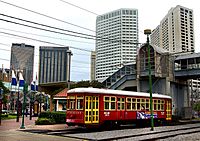 |
457-463 Series 900 Series Replicas |
New Orleans Regional Transit Authority | 1997 | 1997–present | 7; 7 in current operation | 40 |
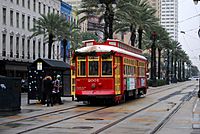 |
2000 Series 900 Series Replicas |
New Orleans Regional Transit Authority | 1999, 2002–2003 | 1999–present | 24; 24 in current operation | 40 |
Historic Streetcar Lines
In the mid-1800s to early 1900s, New Orleans had many streetcar lines, including:
- Poydras-Magazine (January 1835 – March/April 1836) – This was the first true streetcar line in New Orleans.
- Jackson (January 13, 1835 – May 19, 1947) – This long-running line also opened before the St. Charles line. It was later replaced by trolley bus and then diesel bus service.
- Louisiana (February 4, 1850 – 1878, August 27, 1913 – December 27, 1934) – The original line was a branch of the New Orleans & Carrollton. A later line ran from Canal Street up to Louisiana Ave.
- Napoleon (February 4, 1850 – February 18, 1953) – Like the Louisiana Line, the original Napoleon Ave. line was a branch. It was extended to Canal Street when electrified in 1893. This was the longest streetcar line in New Orleans for a time.
- Esplanade (June 1, 1861 – December 27, 1934) – This was the first streetcar line to cross the "back-of-town" section of New Orleans.
- Coliseum (September 1, 1881 – May 11, 1929) – Known as the "Snake Line" because it had many curves.
- Magazine (June 8, 1861 – February 11, 1948) – Its longest route went from Canal Street, up Magazine and Broadway to S. Claiborne Ave. Replaced by trolley bus and later diesel bus service.
- Prytania (June 8, 1861 – October 1, 1932) – Known as the "Silk Stocking Line," it ran through the Garden District.
- Bayou Bridge and City Park (mid-1861 – December 22, 1894) – This early line ran the full length of what is now City Park Ave.
- Tchoupitoulas (August 10, 1866 – July 2, 1929) – This early riverfront line ran the full length of Tchoupitoulas St.
- N. Claiborne (May 13, 1868 – December 27, 1934) – This was a downtown line.
- Tulane (January 15, 1871 – January 8, 1951) – For many years, the St. Charles and Tulane lines operated as a loop. The Tulane Avenue service became a trolley bus and later a diesel bus route.
- Broad (1874 – July 16, 1932) – After 1915, the Broad Line had two branches.
- Clio (January 23, 1867 - September 1, 1932) - This line was the first streetcar line to cross Canal Street.
- Carondelet (July 29, 1866 - September 7, 1924) - This uptown line ran on its namesake street.
- Annunciation (February 27, 1867 - December 23, 1917) and Laurel (August 12, 1913 - July 5, 1939) - These were uptown lines near the River.
- West End (April 20, 1876 – January 15, 1950) – This line was known for its fun ride along the New Basin Canal to the popular West End area on Lake Pontchartrain.
- Spanish Fort (March 26, 1911 – October 16, 1932) – This line went to another amusement area on Lake Pontchartrain.
- S. Claiborne (February 22, 1915 – January 5, 1953) – This line ran along a beautiful grassy median. It was replaced by diesel bus service.
- Desire (October 17, 1920 – May 29, 1948) – This line ran through the French Quarter to its namesake street. It became famous from Tennessee Williams' play A Streetcar Named Desire. The line was converted to buses in 1948.
- Freret (September 7, 1924 – December 1, 1946) – This line was created from parts of the Carondelet line. Replaced by trolley bus and later diesel bus service.
- St. Claude (February 21, 1926 – January 1, 1949) – This was one of the last two streetcar lines to open in New Orleans until the Riverfront line in 1988. Replaced by trolley bus and later diesel bus service.
- Gentilly (February 21, 1926 – July 17, 1948) – This line was unusual because it was named for the neighborhood it served, not the street. It was replaced by diesel bus service.
- Orleans/Kenner interurban (or O.K. Line) – This line operated between 1915 and 1931, connecting New Orleans to Kenner.
Preserved Streetcars
Besides the 35 Perley Thomas-built 900-series streetcars that run on the St. Charles line, several other New Orleans streetcars have been saved.
- Preserved in New Orleans
453: This was the last of 25 Brill semi-convertible cars. It was displayed at the French Market and later the Mint, but weather damaged it. It's known in pictures as the Streetcar Named Desire, even though this type of streetcar likely never ran on that line. It's currently stored at Carrollton Station and could be restored.
919 and 924: These two Perley Thomas cars were originally like the 35 cars on the St. Charles line. They were sold in 1964 when the Canal line closed. The RTA bought them back in 1985 and fixed them up for the Riverfront line, starting in 1988. They were retired again in 1997 when new cars were brought in for the Riverfront line. They are currently stored at Carrollton Station and could be restored.
957: When the Canal line closed in 1964, this car was sold to a railroad club in Texas. It was then sold to a restaurant company, then to a transit authority in Dallas, Texas. Finally, the New Orleans RTA bought it in 1986. It was stored until 1997, when it was rebuilt with a wheelchair lift and modern controls. It became the first of the new 457-463 series cars for the Riverfront line.
- Preserved for Use in San Francisco
952: This Perley Thomas car was sold in 1964. The RTA bought it back in 1990 and fixed it for the Riverfront line. After its second retirement in 1997, it was rebuilt like the St. Charles line cars, given its original number, and sent on a long-term loan to the San Francisco Municipal Railway. It now runs on San Francisco's E-Embarcadero and F-Market & Warves lines as part of their Heritage Fleet.
913: This car was sold to the Orange Empire Railway Museum in California in 1964. Later, it was sold to San Francisco Municipal Railway to help with service there. It has not been fixed up for service yet but is stored for future use.
- Preserved at Museums and Heritage Operations
832: Located at the Pennsylvania Trolley Museum in Washington, Pennsylvania. 836: Located at the Connecticut Trolley Museum in Warehouse Point, Connecticut. 850: Located at the Shore Line Trolley Museum in Branford, Connecticut. These are the last three 800-series cars. All were built by Perley Thomas in 1922. The museums have restored them to look like new and operate them on their museum grounds.
918: Now at the North Carolina Transportation Museum, Spencer, NC, planned for cosmetic restoration.
966: Owned by the Seashore Trolley Museum, Kennebunkport, Maine, and operated at Lowell National Historical Park, Massachusetts.
- Interactive map of New Orleans streetcar network
See also
 In Spanish: Tranvía de Nueva Orleans para niños
In Spanish: Tranvía de Nueva Orleans para niños


